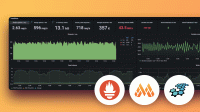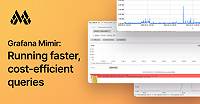This is documentation for the next version of Mimir. For the latest stable release, go to the latest version.
Send native histograms to Mimir
Prometheus native histograms is a data type in the Prometheus ecosystem that makes it possible to produce, store, and query a high-resolution histogram of observations.
Native histograms are different from classic Prometheus histograms in a number of ways:
- Native histogram bucket boundaries are calculated by a formula that depends on the scale (resolution) of the native histogram, and are not user defined. The calculation produces exponentially increasing bucket boundaries. For details, refer to Bucket boundary calculation.
- Native histogram bucket boundaries might change (widen) dynamically if the observations result in too many buckets. For details, refer to Limit the number of buckets.
- Native histogram bucket counters only count observations inside the bucket boundaries, whereas the classic histogram buckets only have an upper bound called
leand count all observations in the bucket and all lower buckets (cumulative). - An instance of a native histogram metric only requires a single time series, because the buckets, sum of observations, and the count of observations are stored in a single data type called
native histogramrather than in separate time series using thefloatdata type. Thus, there are no<metric>_bucket,<metric>_sum, and<metric>_countseries. There is only<metric>time series. - Querying native histograms via the Prometheus query language (PromQL) uses a different syntax. For details, refer to functions.
For an introduction to native histograms, watch the Native Histograms in Prometheus presentation.
Advantages and disadvantages
There are advantages and disadvantages of using native histograms compared to the classic Prometheus histograms. For more information and a real example, refer to the Prometheus Native Histograms in Production video.
Advantages
- Simpler instrumentation: you do not need to think about bucket boundaries because they are created automatically.
- Better resolution in practice: custom bucket layouts are usually not high resolution.
- Native histograms are compatible with each other: they have an automatic layout, which makes them easy to combine.
Note
The operation might scale down an operand to lower resolution to match the other operand.
Disadvantages
- Observations might be distributed in a way that is not a good fit for the exponential bucket schema, such as sound pressure measured in decibels, which are already logarithmic.
- If converting from an externally represented histogram with specific bucket boundaries, there is generally no precise match with the bucket boundaries of the native histogram, and in which case you need to use interpolation.
- There is no way to set an arbitrary bucket boundary, such as one that is particularly interesting for an SLO definition. Generally, ratios of observations above or below a given threshold have to be estimated by interpolation, rather than being precise in the case for a classic histogram with a configured bucket boundary at a given threshold.
The preceding problems are mitigated by high resolution, which native histograms can provide at a much lower resource cost compared to classic histograms.
Instrument application with Prometheus client libraries
The following examples have some reasonable defaults to define a new native histogram metric. The examples use the Go client library version 1.16 and the Java client library 1.0.
Note
Native histogram options can be added to existing classic histograms to get both the classic and native histogram at the same time. Refer to Migrate from classic histograms.
histogram := prometheus.NewHistogram(
prometheus.HistogramOpts{
Name: "request_latency_seconds",
Help: "Histogram of request latency in seconds",
NativeHistogramBucketFactor: 1.1,
NativeHistogramMaxBucketNumber: 100,
NativeHistogramMinResetDuration: 1*time.Hour,
})static final Histogram requestLatency = Histogram.build()
.name("requests_latency_seconds")
.help("Histogram of request latency in seconds")
.nativeOnly()
.nativeInitialSchema(3)
.nativeMaxNumberOfBuckets(100)
.nativeResetDuration(1, TimeUnit.HOURS)
.register();In Go, the NativeHistogramBucketFactor option sets an upper limit of the relative growth from one bucket to the next. The value 1.1 means that a bucket is at most 10% wider than the next smaller bucket. The currently supported values range from 1.0027 or 0.27% up to 65536 or 655%. For more detailed explanation, refer to Bucket boundary calculation.
Some of the resulting buckets for factor 1.1 rounded to two decimal places are:
…, (0.84, 0.92], (0.92, 1], (1, 1.09], (1.09, 1.19], (1.19, 1.30], …
…, (76.1, 83], (83, 91], (91, 99], …
…, (512, 558], (558, 608], (608, 663], …
In Java .nativeInitialSchema using schema value 3 results in the same bucket boundaries. For more information about the schema supported in Java, consult the documentation for nativeInitialSchema.
The value of NativeHistogramMaxBucketNumber/nativeMaxNumberOfBuckets limits the number of buckets produced by the observations. This can be especially useful if the receiver side is limiting the number of buckets that can be sent. For more information about the bucket limit refer to Limit the number of buckets.
The duration in NativeHistogramMinResetDuration/nativeResetDuration will prohibit automatic counter resets inside that period. Counter resets are related to the bucket limit, for more information refer to Limit the number of buckets.
Scrape and send native histograms with Prometheus
Use the latest version of Prometheus or at least version 2.47.
To enable scraping native histograms from the application, you need to enable native histograms feature via a feature flag on the command line:
prometheus --enabled-feature native-histogramsThe above flag will make Prometheus detect and scrape native histograms, but ignores classic histogram version of those metrics that have native histogram defined as well. Classic histograms without native histogram definitions are not effected. To keep scraping the classic histogram version of native histogram metrics you need to set
scrape_classic_histogramstotruein your scrape jobs, for example:scrape_configs: - job_name: myapp scrape_classic_histograms: truein your scrape jobs, to get both histogram version.
Note
Native histograms don’t have a textual presentation at the moment on the application’s
/metricsendpoint, thus Prometheus negotiates a Protobuf protocol transfer in this case.Note
In certain situations, the protobuf parsing changes the number formatting of the
lelabels of conventional histograms and thequantilelabels of summaries. Typically, this happens if the scraped target is instrumented with client_golang provided that promhttp.HandlerOpts.EnableOpenMetrics is set tofalse. In such a case, integer label values are represented in the text format as such, e.g.quantile="1"orle="2". However, the protobuf parsing changes the representation to float-like (following the OpenMetrics specification), so the examples above becomequantile="1.0"andle="2.0"after ingestion into Prometheus, which changes the identity of the metric compared to what was ingested before via the text format.To be able to send native histograms to a Prometheus remote write compatible receiver, for example Grafana Cloud Metrics, Mimir, etc, set
send_native_histogramstotruein the remote write configuration, for example:remote_write: - url: http://.../api/prom/push send_native_histograms: true
Scrape and send native histograms with Grafana Alloy
Use the latest version of Grafana Alloy.
To scrape native histograms, you need to set the
scrape_protocolsargument in theprometheus.scrapecomponent to specifyPrometheusProtoas the first protocol to negotiate:scrape_protocols = ["PrometheusProto", "OpenMetricsText1.0.0", "OpenMetricsText0.0.1", "PrometheusText0.0.4"]For more information, refer to prometheus.scrape in the Grafana Alloy documentation.
To send native histograms to a Prometheus remote write compatible receiver, such as Grafana Cloud Metrics or Mimir, set the
send_native_histogramsargument totruein theprometheus.remote_writecomponent. For example:prometheus.remote_write "mimir" { endpoint { url = "http://.../api/prom/push" send_native_histograms = true } }
Migrate from classic histograms
To ease the migration process, you can keep the custom bucket definition for classic histograms while you migrate to native histograms.
Add the native histogram definition to an existing histogram in the instrumentation.
Let Prometheus or Grafana Alloy scrape both classic and native histograms for metrics that have both defined.
Send native histograms to remote write. Native histograms are sent to remote write by default if classic histograms are scraped.
Start modifying the recording rules, alerts, and dashboards to use native histograms.
After configuring native histogram collection, choose one of the following ways to stop collecting classic histograms.
- Remove the custom bucket definition,
Buckets/classicUpperBounds, from the instrumentation. - Drop the classic histogram series with Prometheus relabeling or Grafana Alloy prometheus.relabel at the time of scraping.
- Stop scraping the classic histogram version of metrics. This option applies to all metrics of a scrape target.
- Remove the custom bucket definition,
Code examples with both classic and native histogram defined for the same metric:
histogram := prometheus.NewHistogram(
prometheus.HistogramOpts{
Name: "request_latency_seconds",
Help: "Histogram of request latency in seconds",
Buckets: []float64{.005, .01, .025, .05, .1, .25, .5, 1, 2.5, 5, 10, 25, 50, 100},
NativeHistogramBucketFactor: 1.1,
NativeHistogramMaxBucketNumber: 100,
NativeHistogramMinResetDuration: 1*time.Hour,
})static final Histogram requestLatency = Histogram.build()
.name("requests_latency_seconds")
.help("Histogram of request latency in seconds")
.classicUpperBounds(0.005, 0.01, 0.025, 0,05, 0.1, 0.25, 0.5, 1, 2.5, 5, 10, 25, 50, 100, Double.NaN);
.nativeInitialSchema(3)
.nativeMaxNumberOfBuckets(100)
.nativeResetDuration(1, TimeUnit.HOURS)
.register();Bucket boundary calculation
This section assumes that you are familiar with basic algebra. Native histogram bucket boundaries are calculated from an exponential formula with a base of 2.
Native histogram samples have three different kind of buckets, for any observed value the value is counted towards one kind of bucket.
A zero bucket, which contains the count of observations whose absolute value is smaller or equal to the zero threshold.
Positive buckets, which contain the count of observations with a positive value that is greater than the lower bound and less or equal to the upper bound of a bucket.
where the index can be a positive or negative integer resulting in boundaries above 1 and fractions below 1. The schema either directly specified out of
[-4, -3, -2, -1, 0, 1, 2, 3, 4, 5, 6, 7, 8]at instrumentation time or it is the largest number chosen from the list in such way thatfor example for factor
1.1:Table of schema to factor:
schema factor schema factor -4 65536 3 1.0905 -3 256 4 1.0443 -2 16 5 1.0219 -1 4 6 1.0109 0 2 7 1.0054 1 1.4142 8 1.0027 2 1.1892 Negative buckets, which contain the count of observations with a negative value that is smaller than the upper bound and greater than or equal to the lower bound of a bucket.
where the
schemais chosen as above.
Limit the number of buckets
The server scraping or receiving native histograms over remote write may limit the number of native histogram buckets it accepts. The server may reject or downscale (reduce resolution and merge adjacent buckets). Even if that wasn’t the case, storing and emitting potentially unlimited number of buckets isn’t practical.
The instrumentation libraries of Prometheus have automation to keep the number of buckets down, provided that the maximum bucket number option is used, such as NativeHistogramMaxBucketNumber in Go.
After the set maximum is exceeded, the following strategy is enacted:
First, if the last reset (or the creation) of the histogram is at least the minimum reset duration ago, then the whole histogram is reset to its initial state (including classic buckets). This only works if the minimum reset duration was set (
NativeHistogramMinResetDurationin Go).If less time has passed, or if the minimum reset duration is zero, no reset is performed. Instead, the zero threshold is increased sufficiently to reduce the number of buckets to or below the maximum bucket number, but not to more than the maximum zero threshold (
NativeHistogramMaxZeroThresholdin Go). Thus, if the threshold is at or above the maximum threshold already nothing happens at this step.After that, if the number of buckets still exceeds maximum bucket number, the resolution of the histogram is reduced by doubling the width of all the buckets (up to a growth factor between one bucket to the next of 2^(2^4) = 65536, refer to Bucket boundary calculation).
Any increased zero threshold or reduced resolution is reset back to their original values once the minimum reset duration has passed (since the last reset or the creation of the histogram).



